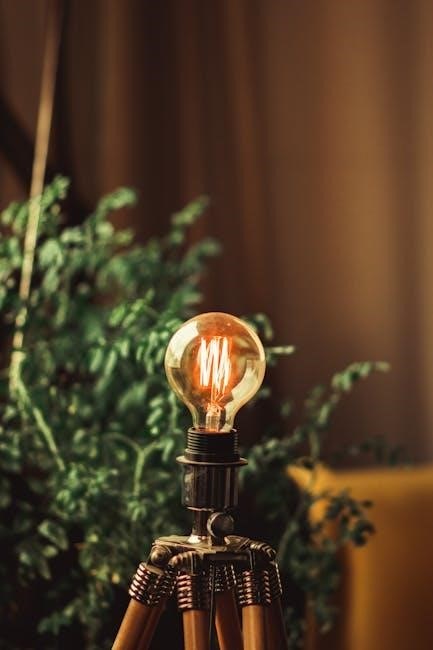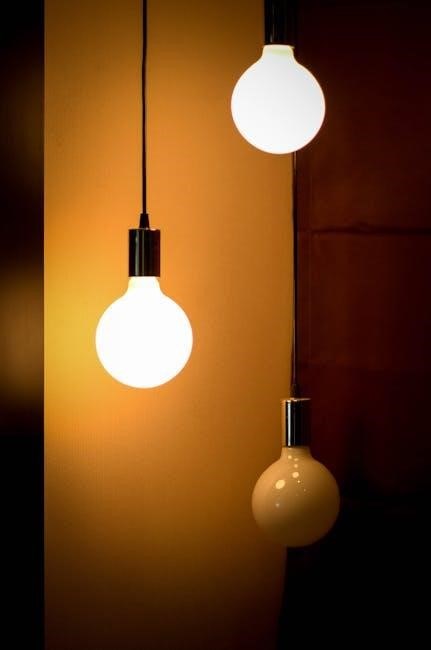Learning about light bulb temperature is essential for creating a cozy atmosphere at home using LEDs and understanding color temperatures.
Understanding Color Temperature
Color temperature is a measure of the light’s warmth or coolness‚ with lower temperatures indicating warmer light and higher temperatures indicating cooler light. The color temperature of a light bulb is typically measured in Kelvin‚ with common ranges including warm white‚ cool white‚ and daylight. Understanding color temperature is crucial in selecting the right light bulb for a particular space‚ as it can greatly impact the ambiance and mood of the room. A light bulb’s color temperature can be influenced by various factors‚ including the type of bulb and the materials used in its construction. By considering the color temperature of a light bulb‚ individuals can make informed decisions about the lighting in their homes and businesses. This knowledge can help create a more comfortable and inviting environment‚ and can also be used to enhance the aesthetic appeal of a space. Using the correct color temperature can make a big difference.

Light Bulb Color Temperature Chart
Light bulb color temperature charts provide a visual guide to understanding different color temperatures and their uses.
Warm Colors and Their Usage
Warm colors‚ typically in the range of 2000K to 3000K‚ are often used to create a cozy and inviting atmosphere in homes. These warm colors are commonly used in living rooms‚ dining rooms‚ and bedrooms to produce a relaxing ambiance. The soft‚ warm light emitted by these bulbs is also often used in decorative lighting‚ such as table lamps and floor lamps‚ to add a touch of warmth and comfort to a room. In addition‚ warm colors are also used in outdoor lighting‚ such as porch lights and patio lights‚ to create a welcoming and inviting exterior. The use of warm colors in lighting can greatly impact the overall mood and ambiance of a space‚ making it feel more intimate and relaxing. By choosing the right warm color temperature‚ individuals can create a peaceful and calming atmosphere in their homes. Warm colors are a popular choice for many lighting applications. They are energy efficient and long lasting.

Choosing the Right Light Bulb
Consider the room’s purpose and desired ambiance when selecting a light bulb using a guide.
Considerations for Home Use
When selecting light bulbs for home use‚ it is essential to consider the room’s purpose and desired ambiance. Different rooms require different types of lighting‚ and the color temperature of the bulb can greatly impact the atmosphere. For example‚ a warm white bulb with a color temperature of 2700K-3000K is often used in living rooms and bedrooms to create a cozy and relaxing atmosphere. On the other hand‚ a cool white bulb with a color temperature of 3500K-4100K is often used in home offices and kitchens to create a brighter and more energizing atmosphere. It is also important to consider the color of the walls‚ flooring‚ and furnishings in the room‚ as they can affect the overall ambiance and color temperature of the space. By taking these factors into account‚ homeowners can choose the right light bulb for their needs and create a comfortable and inviting atmosphere in their home. Using a light bulb color temperature guide can help with this decision.

Light Bulb Color Temperature and Kelvin Scale
Color temperature is measured in Kelvin‚ with higher values indicating whiter light‚ using the Kelvin scale for reference.
Impact of Color Temperature on Electricity Usage
The color temperature of a light bulb does not directly affect its electricity usage‚ as energy consumption depends on the wattage and efficiency of the bulb.
Using a light bulb color temperature chart can help in understanding the different color temperatures and their effects.
The wattage of the bulb is the primary factor in determining electricity usage‚ regardless of the color temperature.
For example‚ a 10W LED bulb with a color temperature of 5000K will consume the same amount of electricity as a 10W LED bulb with a color temperature of 3000K.
This is because the energy consumption of a light bulb is determined by its wattage‚ not its color temperature.
Therefore‚ when choosing a light bulb‚ it is essential to consider the wattage and efficiency of the bulb‚ rather than just the color temperature.
By doing so‚ you can make an informed decision and choose a light bulb that meets your energy needs and provides the desired lighting effect.
Overall‚ the impact of color temperature on electricity usage is minimal‚ and other factors such as wattage and efficiency should be considered when selecting a light bulb.

Differences Between 3000K and 5000K Light Bulbs
3000K bulbs emit warm light‚ while 5000K bulbs emit cool light‚ creating different atmospheres using LEDs.
Creating the Right Ambiance with Light Bulbs
Light bulbs play a significant role in creating the right ambiance in a room‚ and understanding color temperatures is crucial for achieving the desired atmosphere. Using the right light bulb color temperature can make a room feel cozy and inviting‚ or bright and energizing. For example‚ a warm white light bulb with a color temperature of 2700K can create a relaxing ambiance‚ perfect for a bedroom or living room. On the other hand‚ a cool white light bulb with a color temperature of 5000K can create a more energizing atmosphere‚ suitable for a home office or kitchen. By choosing the right light bulb color temperature‚ individuals can create a space that reflects their personality and style‚ and enhances their overall mood and well-being. This can be achieved by considering the color scheme and decor of the room‚ and selecting a light bulb that complements these elements‚ resulting in a harmonious and inviting space.